Determination of the characteristics of inversion reflecting layers in the troposphere on changes in the signal intensity on the near-earth over-thehorizon routes in the middle latitudes
The methodology for determining changes of altitude, elevation
velocity, and reflection coefficient of the elevated inversion layer in the troposphere
is examined based on the results of observation of VHF signals on over-the-horizon
(OTH) routes. Estimations of the elevation velocity and reflection coefficient of the
elevated inversion layers on the results of measuring of the levels of VHF signals in
the zone of the near geometric shadow in the middle latitudes and the
meteorological sounding data using balloons are obtained.

Trang 1
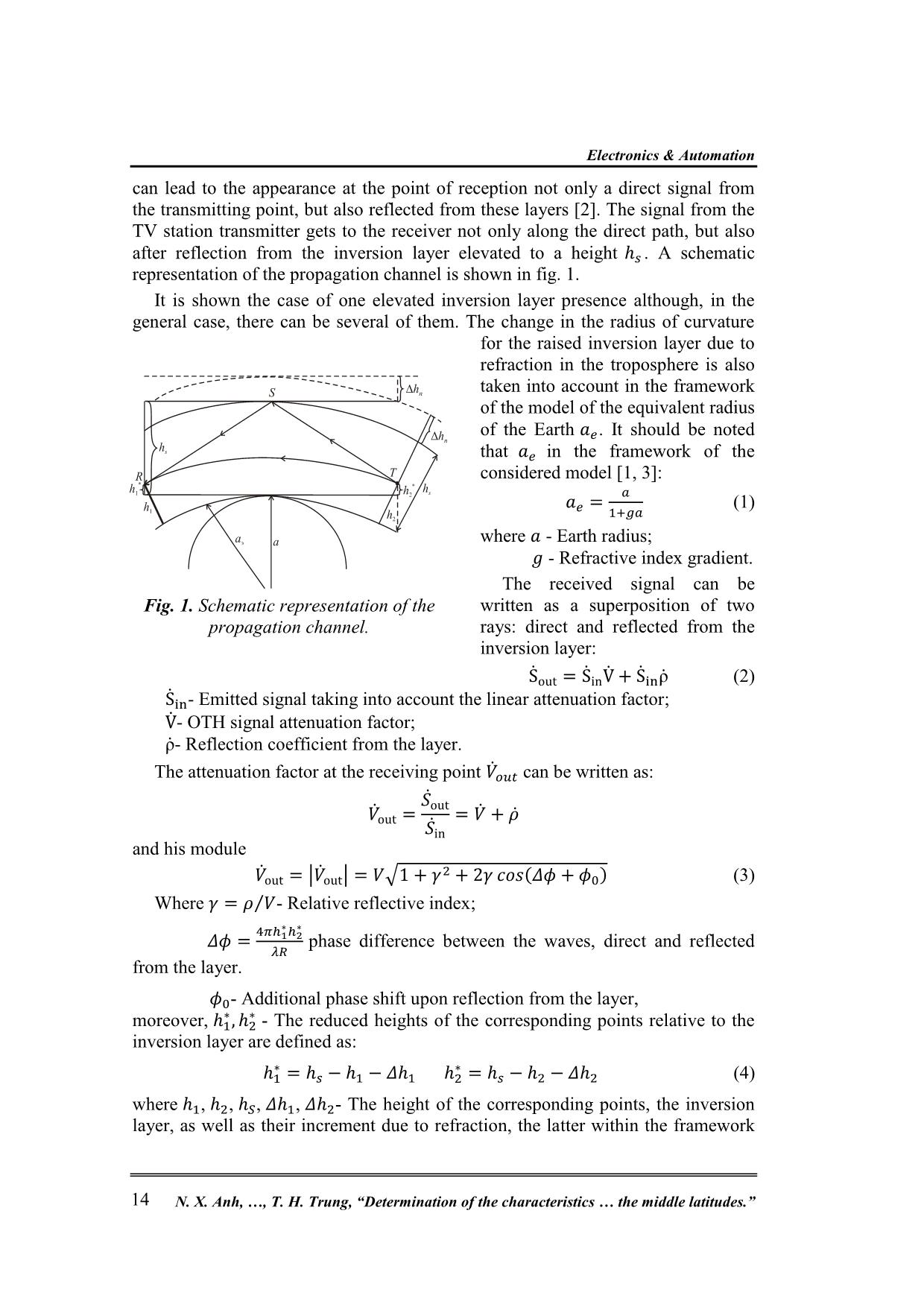
Trang 2
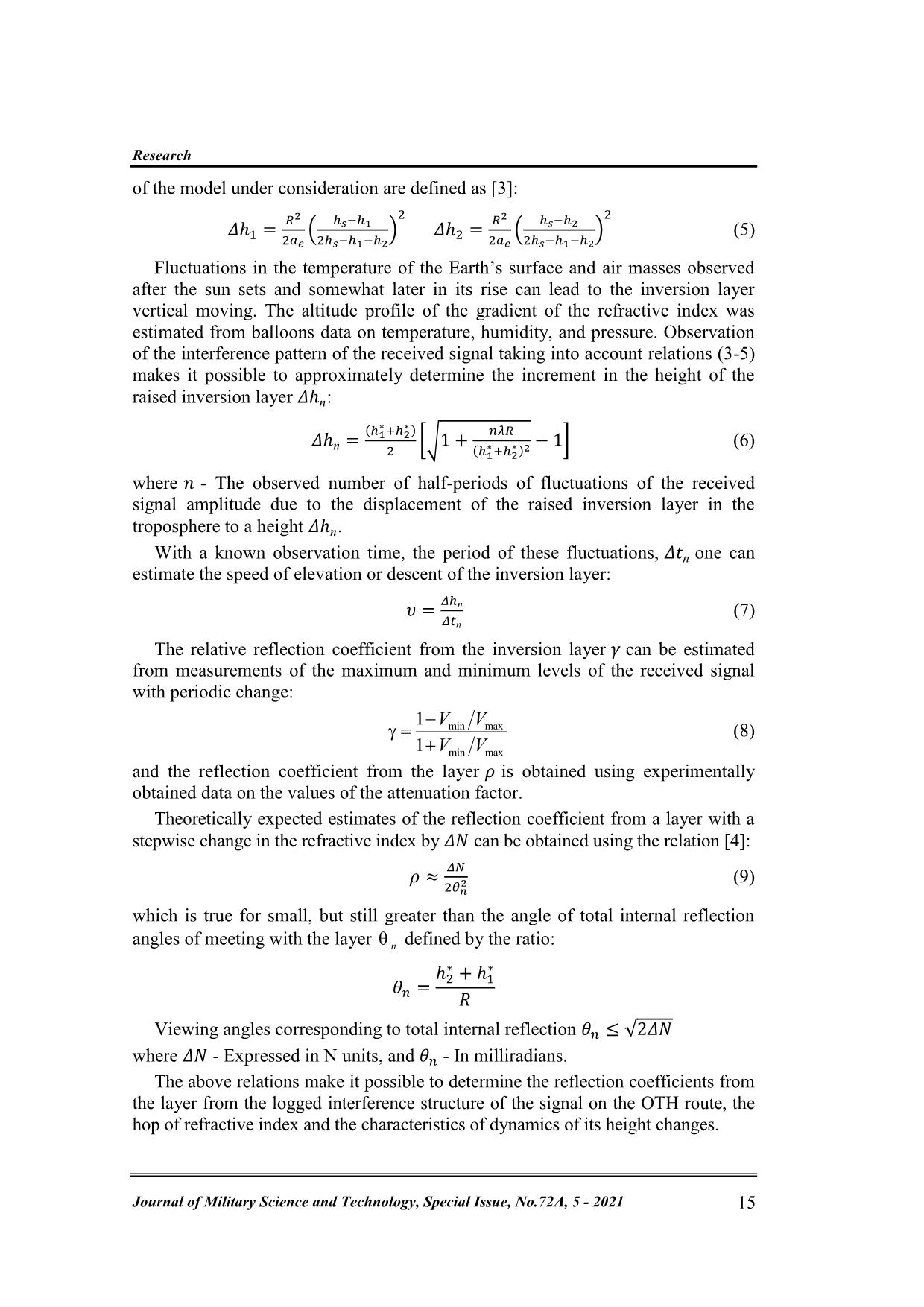
Trang 3
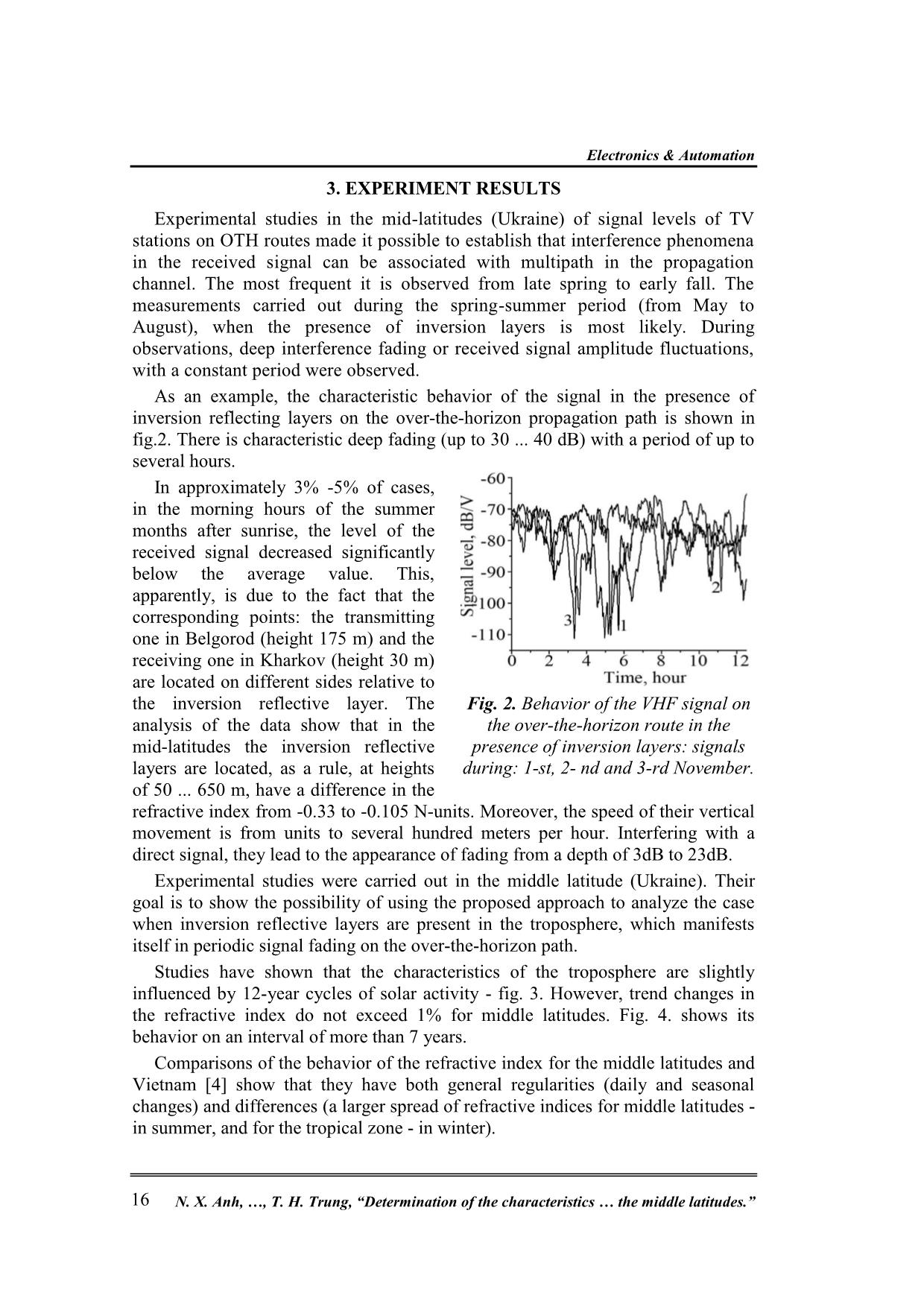
Trang 4
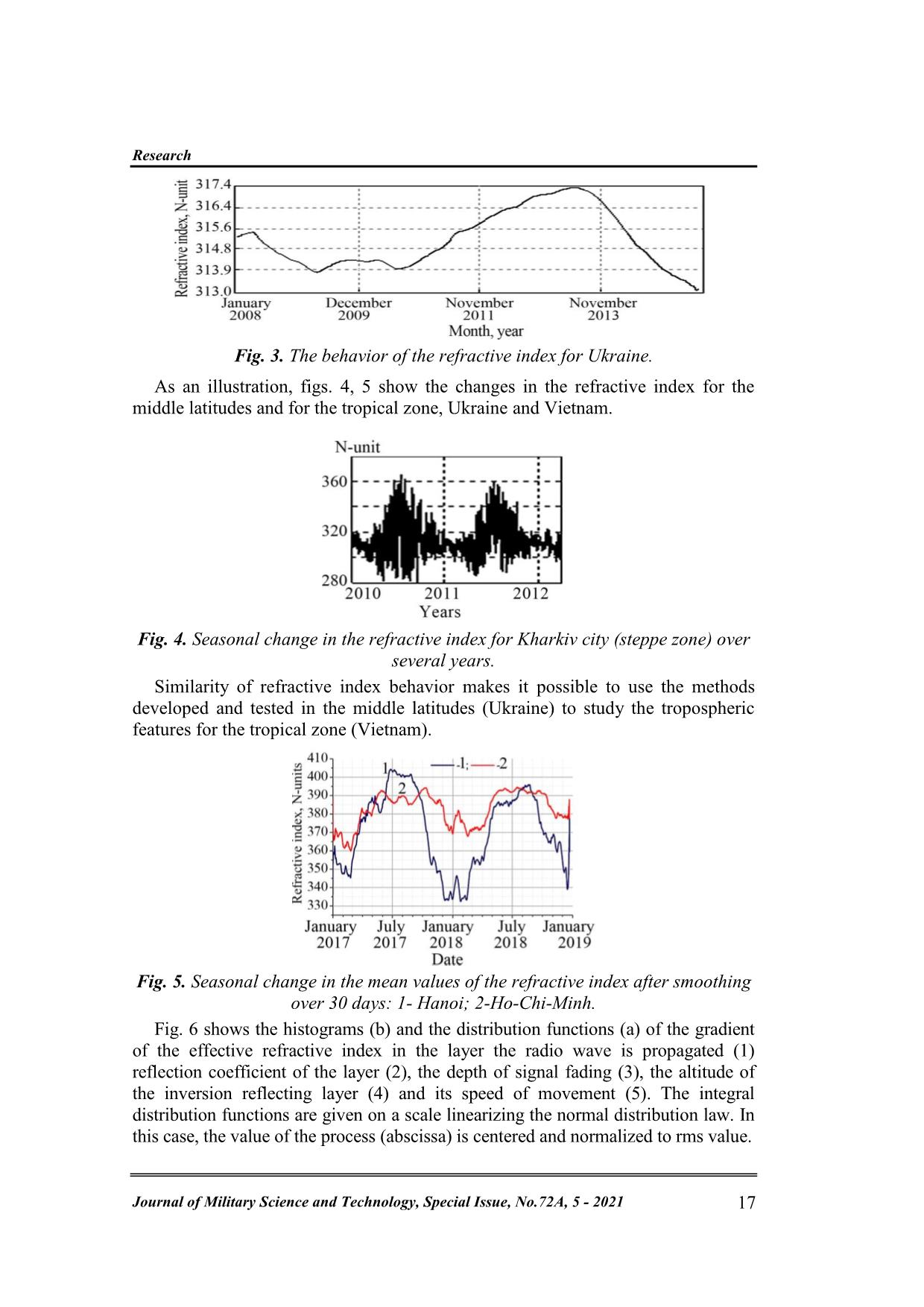
Trang 5
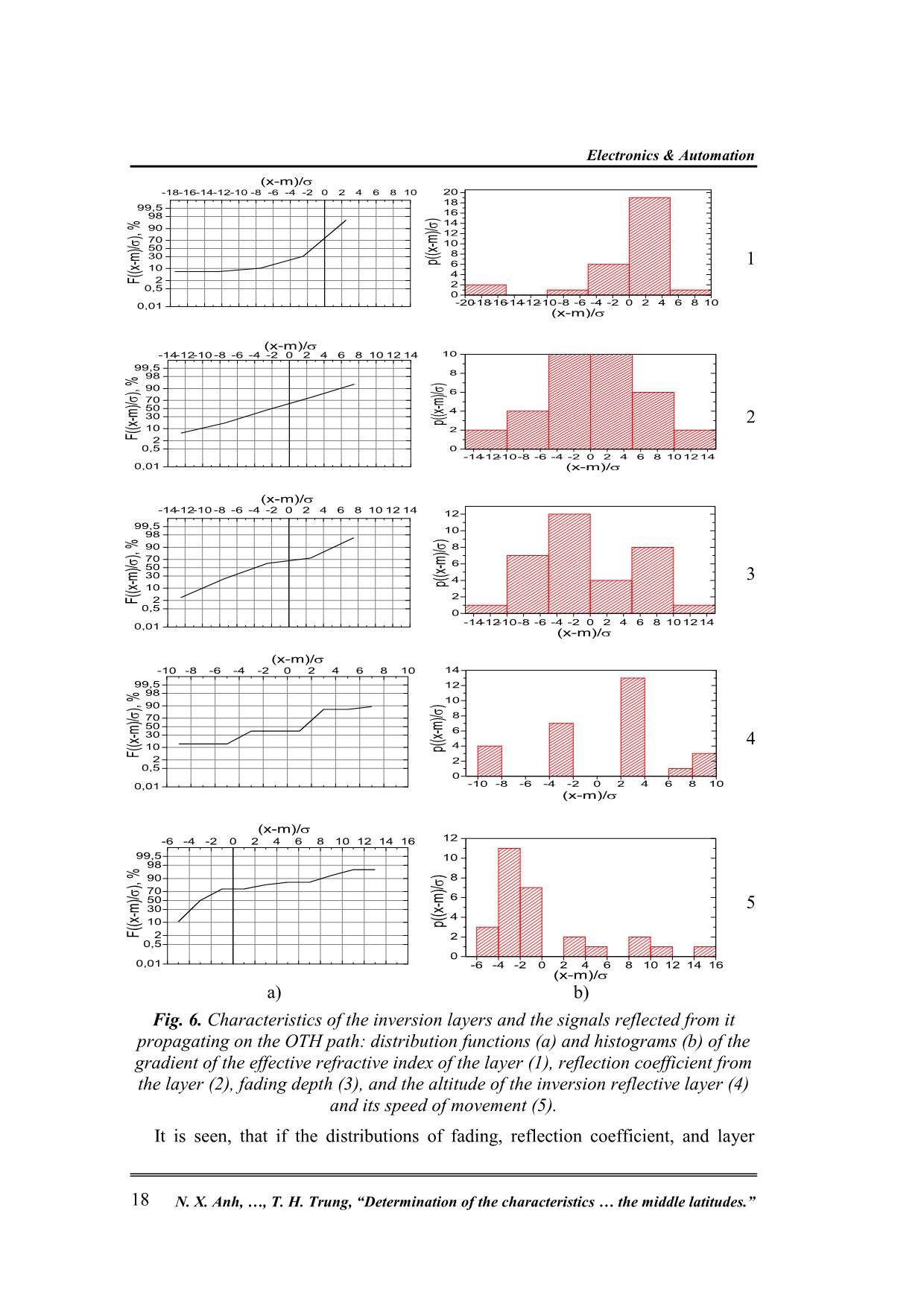
Trang 6

Trang 7

Trang 8
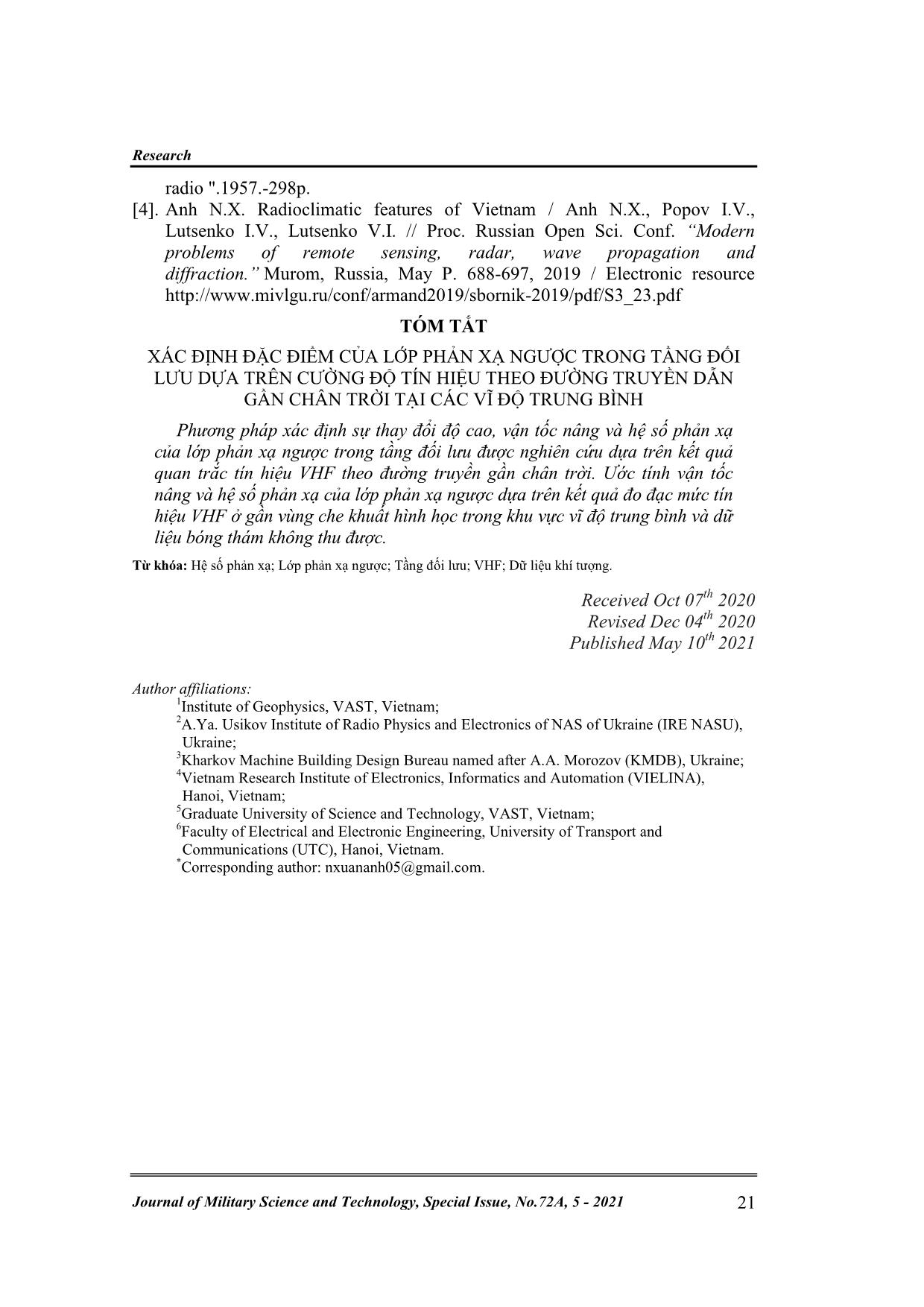
Trang 9
Bạn đang xem tài liệu "Determination of the characteristics of inversion reflecting layers in the troposphere on changes in the signal intensity on the near-earth over-thehorizon routes in the middle latitudes", để tải tài liệu gốc về máy hãy click vào nút Download ở trên
Tóm tắt nội dung tài liệu: Determination of the characteristics of inversion reflecting layers in the troposphere on changes in the signal intensity on the near-earth over-thehorizon routes in the middle latitudes
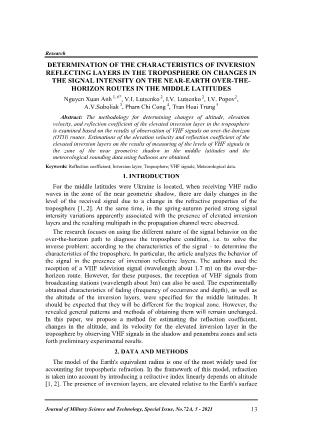
1 VV min max (8) 1 VVmin max and the reflection coefficient from the layer is obtained using experimentally obtained data on the values of the attenuation factor. Theoretically expected estimates of the reflection coefficient from a layer with a stepwise change in the refractive index by can be obtained using the relation [4]: (9) which is true for small, but still greater than the angle of total internal reflection angles of meeting with the layer n defined by the ratio: Viewing angles corresponding to total internal reflection √ where - Expressed in N units, and - In milliradians. The above relations make it possible to determine the reflection coefficients from the layer from the logged interference structure of the signal on the OTH route, the hop of refractive index and the characteristics of dynamics of its height changes. Journal of Military Science and Technology, Special Issue, No.72A, 5 - 2021 15 Electronics & Automation 3. EXPERIMENT RESULTS Experimental studies in the mid-latitudes (Ukraine) of signal levels of TV stations on OTH routes made it possible to establish that interference phenomena in the received signal can be associated with multipath in the propagation channel. The most frequent it is observed from late spring to early fall. The measurements carried out during the spring-summer period (from May to August), when the presence of inversion layers is most likely. During observations, deep interference fading or received signal amplitude fluctuations, with a constant period were observed. As an example, the characteristic behavior of the signal in the presence of inversion reflecting layers on the over-the-horizon propagation path is shown in fig.2. There is characteristic deep fading (up to 30 ... 40 dB) with a period of up to several hours. In approximately 3% -5% of cases, in the morning hours of the summer months after sunrise, the level of the received signal decreased significantly below the average value. This, apparently, is due to the fact that the corresponding points: the transmitting one in Belgorod (height 175 m) and the receiving one in Kharkov (height 30 m) are located on different sides relative to the inversion reflective layer. The Fig. 2. Behavior of the VHF signal on analysis of the data show that in the the over-the-horizon route in the mid-latitudes the inversion reflective presence of inversion layers: signals layers are located, as a rule, at heights during: 1-st, 2- nd and 3-rd November. of 50 ... 650 m, have a difference in the refractive index from -0.33 to -0.105 N-units. Moreover, the speed of their vertical movement is from units to several hundred meters per hour. Interfering with a direct signal, they lead to the appearance of fading from a depth of 3dB to 23dB. Experimental studies were carried out in the middle latitude (Ukraine). Their goal is to show the possibility of using the proposed approach to analyze the case when inversion reflective layers are present in the troposphere, which manifests itself in periodic signal fading on the over-the-horizon path. Studies have shown that the characteristics of the troposphere are slightly influenced by 12-year cycles of solar activity - fig. 3. However, trend changes in the refractive index do not exceed 1% for middle latitudes. Fig. 4. shows its behavior on an interval of more than 7 years. Comparisons of the behavior of the refractive index for the middle latitudes and Vietnam [4] show that they have both general regularities (daily and seasonal changes) and differences (a larger spread of refractive indices for middle latitudes - in summer, and for the tropical zone - in winter). 16 N. X. Anh, , T. H. Trung, “Determination of the characteristics the middle latitudes.” Research Fig. 3. The behavior of the refractive index for Ukraine. As an illustration, figs. 4, 5 show the changes in the refractive index for the middle latitudes and for the tropical zone, Ukraine and Vietnam. Fig. 4. Seasonal change in the refractive index for Kharkiv city (steppe zone) over several years. Similarity of refractive index behavior makes it possible to use the methods developed and tested in the middle latitudes (Ukraine) to study the tropospheric features for the tropical zone (Vietnam). Fig. 5. Seasonal change in the mean values of the refractive index after smoothing over 30 days: 1- Hanoi; 2-Ho-Chi-Minh. Fig. 6 shows the histograms (b) and the distribution functions (a) of the gradient of the effective refractive index in the layer the radio wave is propagated (1) reflection coefficient of the layer (2), the depth of signal fading (3), the altitude of the inversion reflecting layer (4) and its speed of movement (5). The integral distribution functions are given on a scale linearizing the normal distribution law. In this case, the value of the process (abscissa) is centered and normalized to rms value. Journal of Military Science and Technology, Special Issue, No.72A, 5 - 2021 17 Electronics & Automation (x-m)/ -18-16-14-12-10 -8 -6 -4 -2 0 2 4 6 8 10 20 18 99,5 98 16 ) 14 90 12 ), % ), 70 10 50 30 8 p((x-m)/ 1 10 6 4 F((x-m)/ 2 0,5 2 0 0,01 -20-18-16-14-12-10-8 -6 -4 -2 0 2 4 6 8 10 (x-m)/ (x-m)/ -14-12-10 -8 -6 -4 -2 0 2 4 6 8 10 12 14 10 99,5 98 8 ) 90 ), % ), 6 70 50 4 30 p((x-m)/ 2 10 2 F((x-m)/ 2 0,5 0 -14-12-10-8 -6 -4 -2 0 2 4 6 8 101214 0,01 (x-m)/ (x-m)/ -14-12-10 -8 -6 -4 -2 0 2 4 6 8 10 12 14 12 99,5 98 10 ) 90 8 ), % ), 70 50 6 30 4 3 10 p((x-m)/ 2 F((x-m)/ 2 0,5 0 0,01 -14-12-10-8 -6 -4 -2 0 2 4 6 8 101214 (x-m)/ (x-m)/ -10 -8 -6 -4 -2 0 2 4 6 8 10 14 99,5 12 98 10 90 ) ), % ), 70 8 50 30 6 10 4 4 p((x-m)/ F((x-m)/ 2 2 0,5 0 0,01 -10 -8 -6 -4 -2 0 2 4 6 8 10 (x-m)/ (x-m)/ -6 -4 -2 0 2 4 6 8 10 12 14 16 12 99,5 10 98 90 ) 8 ), % ), 70 50 6 30 5 4 10 p((x-m)/ F((x-m)/ 2 2 0,5 0 0,01 -6 -4 -2 0 2 4 6 8 10 12 14 16 (x-m)/ a) b) Fig. 6. Characteristics of the inversion layers and the signals reflected from it propagating on the OTH path: distribution functions (a) and histograms (b) of the gradient of the effective refractive index of the layer (1), reflection coefficient from the layer (2), fading depth (3), and the altitude of the inversion reflective layer (4) and its speed of movement (5). It is seen, that if the distributions of fading, reflection coefficient, and layer 18 N. X. Anh, , T. H. Trung, “Determination of the characteristics the middle latitudes.” Research heights are satisfactorily described by the normal distribution law, then the distribution of its displacement velocity differs significantly from the standard model. The results of the statistical processing of the data are given in table 1. Table 1. Numerical characteristics of reflective inversion layers according to experiment. + h t, , dB , , m , / s + V, dB V, h N g Drop mph t, t, hour uration height height Relative Relative d reflection reflection Reflection Reflection Parameter half period layer lifting lifting layer layer height layer coefficient, coefficient, at 1 am h am at 1 speed speed Mean gradient increment, increment, coefficient max/min max/min Mean 10,35 369,64 -0,0529 0,5080 -24,08 67,32 2,03 38,41 Standard. 0,81 34,15 0,0031 0,0301 0,720 12,75 0,141 6,81 error Median 10 450 -0,048 0,5195 -24,021 35,02 2 24,87 Moda 7 450 -0,049 0,3825 -16,665 34,84 1,5 RMSE 4,74 180,7 0,0164 0,1757 3,8824 67,45 0,813 36,05 Dispersion 22,43 32655,4 0,00027 0,0309 15,07 4550,2 0,662 1299,5 Excess 0,471 -0,541 5,924 -0,515 -0,518 6,376 -0,853 1,921 Asymmetry 0,858 -0,389 -2,386 0,170 0,0487 2,592 0,374 1,684 Interval 19,5 600 0,072 0,669 14,474 258,69 3,25 131,95 Minimum 3,5 50 -0,105 0,1987 -31,139 23,77 0,5 9,27 Maximum 23 650 -0,033 0,8678 -16,665 282,46 3,75 141,22 Sum 352 10350 -1,532 17,2735 -698,4 1885,0 67,15 1075,568 Score 34 28 29 34 29 28 33 28 The results of processing of the received signals of a HF (175 MHz frequency) TV channel (the Belgorod – Kharkiv OTH route with a length of 71 km) according to the developed method, as well as data of aerological sounding of the height of the inversion layer location made it possible to establish that fading with a depth of more than 10 dB is observed in less than 40% of cases, and over 20 dB no more than 5%. The height of the reflective inversion layer in approximately 85% of cases does not exceed 0.5 km. In this case, the differences in the refractive index in the layer are, as a rule, 6-14 N units. The range of variation of reflection coefficients from inversion layers ranged from -20 dB to -32 dB. Moreover, the most probable (with a probability of about 0.6) values of the relative reflection coefficient ranged from 0.4 to 0.8. The estimates obtained are in satisfactory agreement with the theoretically expected ones. The speed of change of the height of the inversion reflective layer obtained using ratios in approximately 70% of cases lies within 10-30 mph. 4. CONCLUSIONS 1. A technique is proposed for studying the characteristics of inversion layers in the troposphere from the characteristics of signal fading along the over-the-horizon path. It has been shown theoretically and experimentally confirmed that the Journal of Military Science and Technology, Special Issue, No.72A, 5 - 2021 19 Electronics & Automation selected spectral components of fluctuations of the signal received on the over-the- horizon path make it possible to estimate the relative reflection coefficient from the layer, and hence the difference in the refractive index in it, as well as the altitude of its location and the speed of its vertical movement. This approach, based on the use of spectral analysis of the signal structure on over-the-horizon paths to study the structure of layers in the troposphere, was proposed for the first time and for the first time made it possible to obtain their characteristics (number, frequency of occurrence, average altitude and speed of its vertical movement, as well as the difference in refractive index in the layer) for the middle latitudes. A similar approach can be successfully used to study the characteristics of layers in the tropical zone of Vietnam. 2. Experimental studies carried out in the middle latitudes using the radiation of TV centers made it possible to establish that in most cases the number of inversion layers does not exceed 2 with a difference in the refractive index at the layer boundary of 6 ... 14 N units. The height of their placement for mid-latitudes, as a rule, does not exceed 1 km, and the lifting speed of several hundred meters per hour. 3. A standard Gaussian model can be used to describe fading statistics, reflection coefficients, and altitudes of inversion layers. At the same time, the distributions of the effective gradient of the refractive index in the layer, which is essential for the propagation of radio waves and the velocities of the inversion layers, differ from the Gaussian models. 4. The features of the behavior of the signal on the over-the-horizon path, which are characteristic of various states of the troposphere, were established, and classification criteria were formulated that would allow the signal behavior to diagnose the refractive state of the troposphere and study the frequency of occurrence of various situations. The obtained quantitative estimates are typical for the middle latitudes and will be different for the tropical zone, however, the formulated classification criteria will make it possible to use the approach proposed by the authors to study the features of the troposphere of the tropical zone using emissions from television centers and VHF broadcasting stations on over-the-horizon routes, which opens up new opportunities for studying the radio- climatic features of Vietnam. Acknowledgment: This work was supported by the National Academy of Sciences of Ukraine and the Ministry of Industry and Trade of Vietnam. REFERENCES [1]. Anh N.X. “Estimation of Atmospheric Parameters Using Radio Occultation Method” / N.X. Anh, P.L. Khuong, V.A. Kabanov, V.I. Lutsenko, I.V. Lutsenko, V. B. Sinitsky // J. Geology, Series B.-2008.-No. 31-32.- P.60-66. [2]. Lutsenko V. I. “On the possibility of determining the characteristics of reflecting layers in the troposphere above land from variations in the levels of VHF signals on horizontal lines”. / V.I. Lutsenko, I.V. Lutsenko, E.N. Belov, S.I. Khomenko // "Visnyk of V.N. Karazin Kharkiv National University Series "Radio Physics and Electronics".- 2002.- No. 570.- P. 203-204. [3]. A.G. “Arenberg Propagation of decimeter and centimeter waves”. M .: “Sov. 20 N. X. Anh, , T. H. Trung, “Determination of the characteristics the middle latitudes.” Research radio ".1957.-298p. [4]. Anh N.X. Radioclimatic features of Vietnam / Anh N.X., Popov I.V., Lutsenko I.V., Lutsenko V.I. // Proc. Russian Open Sci. Conf. “Modern problems of remote sensing, radar, wave propagation and diffraction.” Murom, Russia, May P. 688-697, 2019 / Electronic resource TÓM TẮT XÁC ĐỊNH ĐẶC ĐIỂM CỦA LỚP PHẢN XẠ NGƯỢC TRONG TẦNG ĐỐI LƯU DỰA TRÊN CƯỜNG ĐỘ TÍN HIỆU THEO ĐƯỜNG TRUYỀN DẪN GẦN CHÂN TRỜI TẠI CÁC VĨ ĐỘ TRUNG BÌNH Phương pháp xác định sự thay đổi độ cao, vận tốc nâng và hệ số phản xạ của lớp phản xạ ngược trong tầng đối lưu được nghiên cứu dựa trên kết quả quan trắc tín hiệu VHF theo đường truyền gần chân trời. Ước tính vận tốc nâng và hệ số phản xạ của lớp phản xạ ngược dựa trên kết quả đo đạc mức tín hiệu VHF ở gần vùng che khuất hình học trong khu vực vĩ độ trung bình và dữ liệu bóng thám không thu được. Từ khóa: Hệ số phản xạ; Lớp phản xạ ngược; Tầng đối lưu; VHF; Dữ liệu khí tượng. Received Oct 07th 2020 Revised Dec 04th 2020 Published May 10th 2021 Author affiliations: 1Institute of Geophysics, VAST, Vietnam; 2A.Ya. Usikov Institute of Radio Physics and Electronics of NAS of Ukraine (IRE NASU), Ukraine; 3Kharkov Machine Building Design Bureau named after A.A. Morozov (KMDB), Ukraine; 4Vietnam Research Institute of Electronics, Informatics and Automation (VIELINA), Hanoi, Vietnam; 5Graduate University of Science and Technology, VAST, Vietnam; 6Faculty of Electrical and Electronic Engineering, University of Transport and Communications (UTC), Hanoi, Vietnam. *Corresponding author: nxuananh05@gmail.com. Journal of Military Science and Technology, Special Issue, No.72A, 5 - 2021 21
File đính kèm:
 determination_of_the_characteristics_of_inversion_reflecting.pdf
determination_of_the_characteristics_of_inversion_reflecting.pdf

